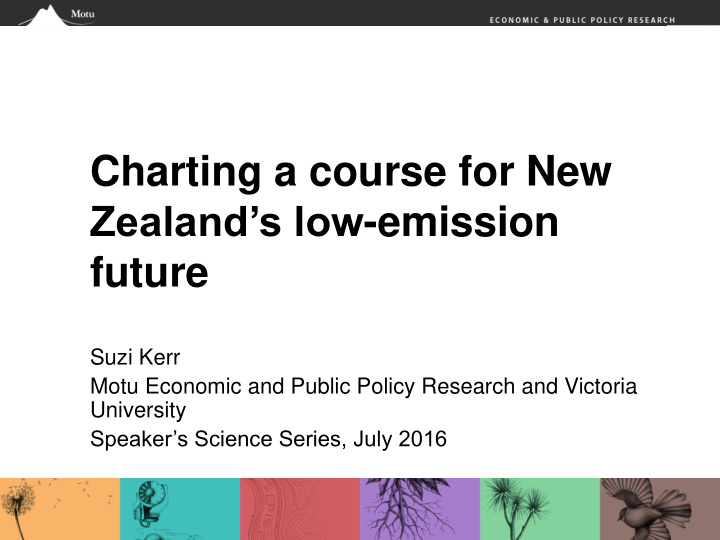



Charting a course for New Zealand’s low -emission future Suzi Kerr Motu Economic and Public Policy Research and Victoria University Speaker’s Science Series, July 2016
Stabilising climate change requires net emissions of long-lived GHGs to drop to zero If we want to limit warming to 2 degrees, net CO 2 emissions would have to drop to zero well before 2100, and even faster in developed countries At current rates, the remaining carbon budget will be exhausted within the next 30 years
Change is continuous • Alternative is not status-quo. • Bring in the new – and usher out the old.
Net-Zero-Emissions Future Where Are We Heading? Low well- High well- being being We are here
New Zealand’s annual gross and net GHG emissions continue to increase. (‘Net’ accounts for CO2 removed by forests.)
Multiple entry points – no silver bullet: Composition of average household emissions
What we buy also has an impact… 50 Top 20% of emitting households at Top 20% each level of expenditure have 45 emissions 80-90% higher than bottom 40 20% of households 35 Driven by diet and transport choices Emissoins, t-CO2eq 30 Bottom 20% Top 20% 25 20 Bottom 20% 15 10 5 0 $48,000 $120,000 Expenditure, 000s NZ$ Other Meat/dairy HH Energy Petrol Air travel
Achieving a transition relies on carefully planned policy interventions and behaviour changes at individual, business, city, organisational levels.
Increasing renewable electricity Increasing the share of renewable electricity generation to reach New Zealand’s 90% target by 2025 is technically and economically possible.
Low emission electricity enables other reductions Reduction will involve many different actions As technologies evolve, the ‘best’ reduction path will also evolve
Forest planting and harvesting Significantly increasing the land area of plantation forests could offset up to a quarter of our total GHG emissions over the next two to three decades. Forest sinks can only be an interim solution because there is a limit to the area of available land.
Agriculture Absolute emissions are projected to continue to increase, while emissions intensity falls Source: Reisinger and Clark (2015)
Agriculture Productivity per animal Efficiency of farms (excluding energy use and off-farm emissions) Source: Reisinger and Clark (2015)
Supporting low-carbon choices We can start immediately by deploying low-risk mitigation actions whilst planning for and trialling more ambitious emission reductions options and system changes to commence the necessary transition to a low-carbon economy. An effective emissions trading system is one essential part of any policy package. Other important roles for government include: Support for identifying and trying new ideas Meeting infrastructure needs and helping coordinate major shifts Removing barriers to change
Enabling societal engagement Evidence for mitigation pathways for New Zealand is deficient. This limits effective public engagement and debate about our future options. Investment in data gathering and deeper analysis will help refine early mitigation actions and support a transparent public debate about longer term desirable and feasible mitigation pathways. An independent board or entity to provide evidence- based advice to Parliament and the public would be valuable.
Recommend
More recommend